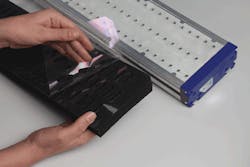Reliable handling plays a key role in automated production processes, whether moving individual components, packaging materials, or finished goods. Regardless of the product, the goods need to be transported quickly and safely, without damage, and with a cost-efficient handling system.
One particular problem involves the automated pick-up and transport of a large number of products, all at once, that have been sorted, stacked in layers, or arranged on pallets. Schmalz Inc., addresses this challenge with its SPZ vacuum layer-gripping system. The SPZ lets users handle a wide range of products, includes cardboard boxes, composite packaging, bottles, cans, glass jars, and even pliant sacks.
The main elements making up the layer grippers are Schmalz FXC/FMC large-area grippers. These modules, made of lightweight, low-profile aluminum extrusions, connect to fast-cycling, high-flow valves. In the SPZ layer gripper, several of these modules are interconnected to provide vacuum lifting power over a pallet-sized area.
The basic version can load and unload an entire layer of products sitting on a pallet. Quick and efficient operation minimizes cycle times. The SPZ is appropriate for handling crates, cartons, foil packages, rigid containers, and even porous or rough workpieces. The gripping system can also accommodate various package sizes and layer arrangements, and is not affected by gaps in the layering pattern. And a major advantage of the layer gripper: it doesn’t need to be re-engineered for product changes. This eliminates costly setup times.
The suction area, the interface between the gripper and the product, is either a foam sealing plate or an array of suction pads. The rugged, yet flexible, foam works well when handling rigid work pieces. Suction pads, on the other hand, are better suited for non-rigid materials such as shrink-wrapped products, plastic bags, and cardboard boxes.
The unit’s valve network lets the controls turn off unused suction cells, which conserves energy and ensures no gripper change is necessary for partially loaded pallets. The system is suitable for use in distribution centers, as well as for production packaging stations.
Other options
The modular system is also available with optional mechanical clamping (SPZ-M). Mechanical grippers, which can be controlled pneumatically or electrically, provide additional holding force and stability. The setup is intended for products that are difficult to pick up using vacuum alone, due to the package’s shape or surface properties. Typical examples include PET bottles, shrink-wrapped goods, and loosely packed or partially filled cardboard boxes.
Another variant (SPZ-M-C) of the basic version features mechanical clamping and a skirt that houses the packages. As explained above, mechanical clamping adds stability and holding power. The engineered skirt creates a vacuum suction chamber that provides additional holding force for moving products that are cumbersome to handle with conventional vacuum grippers, such as containers with removable and hinged lids; and to handle product layers en masse that otherwise could only be transported manually, such as loose cans on a cardboard tray.
In addition to handling difficult goods, the suction chamber also compensates for unevenness in the layers, as well as “chimneys” created by gaps in the layering pattern.
Swapping out sealing foam
Heavy-duty, yet flexible, polyester sealing foam on the layer-gripper body is suited for handling rigid work pieces such as wooden boards, as well as glass jars and cans with a continuous edge. Foam with an optional filter screen is available to protect the system from contamination.
A modified acrylic adhesive secures the foam to the vacuum gripper’s valve module. Despite its durability, over time the foam will eventually wear out. Fortunately, it can be readily replaced. The foam and old adhesive remove easily without complicated sheet cleaning, and without leaving a residue on the gripper that could lead to malfunctions. A new piece of foam is then glued to the existing gripping module, quickly returning the unit to service with minimal costs for the replacement parts.
Finally, a special version of the layer gripper (SPZ-M-Cool) is available for use in deep-freeze and cold-room applications, for handling frozen food, cooled beverages, and other chilled goods. This version is suitable for transporting products at temperatures in the range of -20°F. Standard units are rated for temperatures ranging from about 40° to 104°F (5° to 40°C).
Design specifics
Layer grippers are designed to standard Euro (47.2 × 31.5 in. or 1.2 × 0.8 m) and industry (47.2 × 39.4 in. or 1.2 × 1 m) pallet dimensions. Custom sizes — for example, for half pallets — are also available. Standard units can carry a maximum weight of approximately 250 kg (550 lb). Pick-and-place time is about 6 sec for gripping and 3 sec for release. The units also include sensors for detecting product position and gripping force.
The SPZ layer gripper includes state-of-the-art flow-control valves and vacuum check valves, ensuring fast actuation, ample gripping force, and energy-efficient operation.
Mason Nicholson is marketing coordinator at Schmalz Inc., Raleigh, N.C. For more information on large-area vacuum gripping systems, click here.
About the Author

Leaders relevant to this article:




